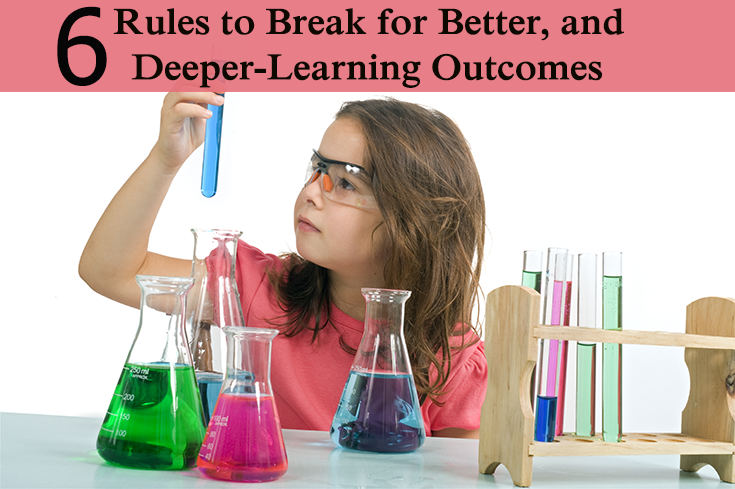6 Rules To Break For Better, Deeper-Learning Outcomes
Posted by Network Support · Leave a Comment
Incorporate Deeper-Learning as you empower students to seek knowledge from many sources, use tools relevant to their lives, and embrace the 21st century…
What do today’s students really need to learn in order to succeed, not only in the classroom, but also later on in college, careers, and life as engaged citizens? The answer – “Deeper-Learning”.
The 20th-century approach to education, which favored methods such as lectures and rote learning, is standing in the way of making school relevant to more students. Fortunately, research is catching up with our intuition and validating the practices that we know works in the classroom. One in particular – it’s called Deeper-Learning.
Deeper-Learning is simply the delivery of rich core content to students in innovative ways, that allow learning and application of what they have learnt. Rigorous core content is at the heart of the learning process; true Deeper-Learning is developing competencies that enable graduating high school students to be college and career ready and then make maximum use of their knowledge in life and work.
The Benefits
Deeper-Learning prepares students to:
- Know and master core academic content;
- Think critically and solve complex problems;
- Work collaboratively;
- Communicate effectively; and
- Be self-directed and able to incorporate feedback.
Academic knowledge and skills alone won’t enable students to successfully navigate a rapidly changing world or engage fully in the ever-evolving 21st century workplace. Students must be able to communicate their ideas effectively, think creatively, work collaboratively to solve problems, and manage their own learning. They need to develop dispositions—or mindsets—that empower them to confront new challenges, take initiative, and persevere through difficulties and setbacks.
So how can educators achieve these 21st-century outcomes? Let’s start by breaking the rules of the 20th century’s all-expansive curriculum where students “sat and got knowledge.” Here are some rules teachers can help students break:
1. Don’t just learn from your teacher.
Teachers are only one source of knowledge. Students could be encouraged to learn about a subject of their interest, from a local nonprofit in the area or from expert scientists and researchers through mini-courses.
2. Learn what you want to learn.
Encourage students to take responsibility for their own learning by pursuing their interests. For example, if a student has a love for Math and has mastered all of his high school classes, he could be encouraged to take advanced engineering courses at the university, including engineering design, programming with Math lab, statistics and multivariate calculus.
3. Use social media in school, too.
Blogging, Twitter, and Facebook aren’t just for selfies! Students can use social media for multiple purposes. For example, students could Skype with the authors of the books they read in English or history classes to learn from them or students in the technology education class could learn about the design process through a YouTube video of experts and professionals.
4. Don’t wait to be told what to do.
Provide opportunities for students to turn their interests into learning endeavors such as practical projects. For example, teachers could lead a literacy project by involving students in designing original comic books to help elementary students learn English.
5. Learn outside of school.
Help students identify resources beyond what the school can provide a way to enhance their learning. For example, students could be encouraged by offering extra college credits if they take courses online from possible internship placements and complete their stipulated extra learning hours.
6. Fail, try, and try again.
Failing is a process for real learning and achievement. Students could be taught about failure by allowing them to make mistakes and learn from them. For example, students could be encouraged to learn about design principles used to build bridges, and later asked to build their own model bridge and test it on a shaker table. If the bridge collapses, teachers could use the failure as an opportunity to talk to students about the need to constantly “prototype” or test their work and improve upon it.
The aforementioned rules are just the start. So break rules, particularly those 20th-century rules, that stop teachers from steering their students to a place where they are empowered to self-direct their learning.
Like this article for teachers?
Browse the Professional Learning Board COURSE CATALOG to find related online courses for teachers in your state. Professional Learning Board is a leading provider of online professional development classes that teachers use to renew a teaching license or renew a teaching certificate.





